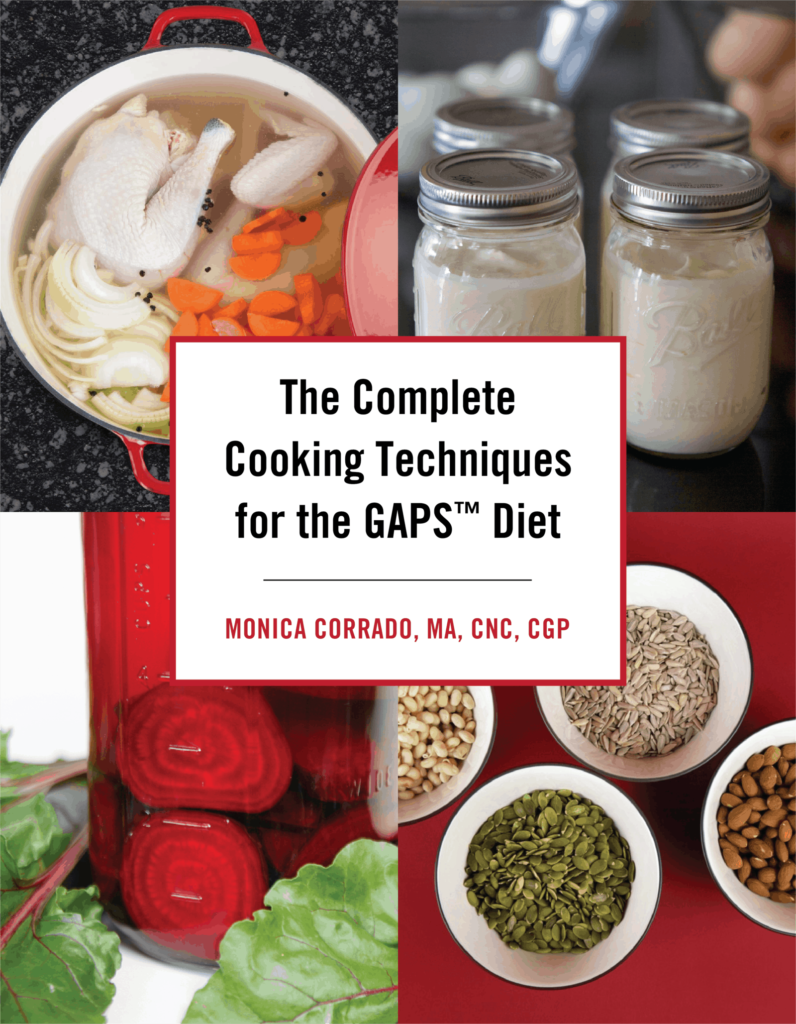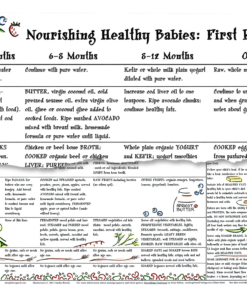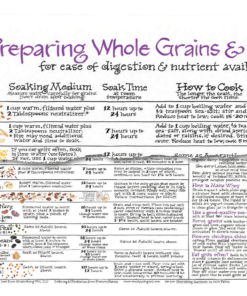SRP Managing Editor Danielle LeBaron is kicking off our new series, Selene River Press Practitioner Interviews, with speaker, author, and teacher Monica Corrado. The two recently sat down for a wide-ranging discussion about food, inspiration, and the fascinating path Monica’s life has taken. Currently working on the second edition of her masterful book, The Complete Cooking Techniques for the GAPS Diet, Monica discusses her passion, cooking for well-being, with SRP.
To listen to the interview, click here.
Danielle LeBaron: Hello, and welcome to Selene River Press Practitioner Interviews, a series of short conversations with some of our prominent writers, authors, and practitioners. Today we’re speaking with Monica Corrado, author of The Complete Cooking Techniques for the GAPS Diet. Monica, thanks so much for being with us.
Monica Corrado: Hello! Thanks for having me.
Danielle: I’m excited to talk to you. Let us know a little bit about you and your story.
Monica: Okay, this could take a while! I’m Monica Corrado. I’m a teaching chef. I’m a Certified Gaps Practitioner. I’m a holistic nutritionist. And I’ve been dubbed by Dr. Natasha Campbell-McBride the “GAPS chef.” So those are my credentials. I teach people how to be well through food.
I started about 20 years ago, when I met Sally Fallon (now Sally Fallon Morell), president of the Weston A. Price Foundation. She asked me to start teaching traditional food cooking classes based on the principles of the Weston A. Price Foundation. Since then I’ve done a lot with food. I owned my own organic and biodynamic catering company. I did prepared foods. I did a “dirt dinner” service. I’ve taught traditional cooking at different universities. And I’ve been really involved in the raw milk movement and the sustainable food movement, or food security, if you will.
The first turn in my life was meeting Sally Fallon. But the next turn was meeting Dr. Natasha Campbell-McBride when she came to the U.S. to talk about children’s health. That’s when I learned about the GAPS diet. I think that was, golly, 2008— a long time ago.
So what do I do? I teach people how to cook. I teach people how to be well with food. How to source real food. How to cook it in a way that makes it digestible and maximizes its nutrient density. I also work with clients one on one. I’m a speaker. I’m an author. I’m a writer. And I’m all about cooking for well-being. That’s what I call it.
Danielle: What an incredible bio. I’ve known you for years, and I didn’t know most of those things.
Monica: Well, there’s more on my website, Simply Being Well. But that’s the thumbnail sketch.
Danielle: I love it. We’ve talked a little bit about this, but I want to know what really inspired you to get started with this entire path your life has taken?
Monica: You know, a series of happy accidents? My background is actually in national security. You probably didn’t know that either! I was living in Washington, DC, and I’d done a lot of different jobs in national security. I can’t tell you about them because, you know, they’re classified. But I got tired of schlepping in that industry as a woman with only a master’s and no military background. I thought, what am I going to do with my life? Here I am. I’ve got a bunch of years under my belt writing research and working on the Hill. And I was miserable.
So I went back to what I always loved—food. I love eating food, being with food, making food. I remember helping my mother in the kitchen back when I first could really help in the kitchen, when I was just six or seven. I thought, I’m going to look into food. First, I went into food service. I took any could job I could get at the Mayflower Hotel in Washington, DC, two blocks from the White House. It was a four-star hotel. I was the food and beverage division controller. I was a catering manager. I was convention manager. I ran restaurants, bars, whatever. I learned a lot.
When I burnt out of that, I started my own catering company for organic and biodynamic foods. I looked at it from the question of how food is grown, sustainable farming, etc. I met Joel Salatin, the “Priest of High Pasture. He’s the number one grass farmer at his Polyface Farm.
I kept making the connections of real food, real food, real food. If the Earth is sick, the food I’m eating is sick. Confined animal feeding operations, genetically modified foods, pesticides, herbicides, glyphosates, whatever—I kept connecting the dots. People are sick. People’s brains aren’t working. I got very involved in the whole question of autism and brain function. It was a confluence of factors, but I kept searching. What’s the connection between what we eat and how we feel? What we eat and how our brains work? What we eat and how our bodies operate? In terms of my career, it really started as loving food and looking at these connections.
And then I met Sally Fallon. She wanted access to my raw milk share. In Maryland, at this time, raw milk was illegal. It’s not anymore, thanks to the Campaign for Real Milk. But when it still was illegal, my CSA would drive to Pennsylvania once a week to pick up our vegetables—and our raw milk. We drove it back over state lines—a felony, by the way.
And that’s how I met Sally Fallon. It led to a lot of things. She knew I had a catering company, and she asked me to cater the first Wise Traditions conference. It was about 19 people in a church basement and Silver Spring, Maryland. But then it went from 250 people to over 1,500 people, and it got too big for me to handle. Sally also asked me to be on the honorary board of the Weston A. Price Foundation, almost since it started.
When I catered those first Wise Traditions conferences, someone from the conference called me one morning at my home. She asked if I would teach Nourishing Traditions, Sally Fallon’s cookbook. She was an assistant manager at one of the local coops in Bethesda, Maryland. They had the book, but nobody knew how to do it. It’s big and it’s complicated. I said sure, why not?
That was the beginning. I taught at the coop before they opened on Sunday mornings, at a six-foot table with an electric burger burner plugged in. I taught bone broth, believe it or not, in huge pots on the electric burner. I’ve been teaching cooking ever since.
A few years later, I was still teaching my Nourishing Traditions cooking classes, and one of the students asked if I would you teach GAPS. And I thought…Yeah, I’ve got the book. Yeah, I can teach GAPS! I went and developed the first GAPS cooking classes, and they just took off.
So that’s the journey. I just kept being invited to do something more. Will you cater my conference? Sure. You know how to do this, can you teach it? Sure. Yes, I can!
Danielle: That’s a very inspiring story. Thank you so much for sharing that. You’ve talked about a few people already, but who are your main role models, personally or professionally, who helped you get to where you are?
Monica: I don’t know about role models. I don’t think that I’ve modeled myself after anyone. But I do have people I admire, people who really helped me in terms of representing certain principles. For example, Sally Fallon again. She’s all about food, farming, and the healing arts. She’s about connecting people to real food, connecting the consumer directly to the farmer. And obviously she wrote Nourishing Traditions, which has had a big influence on my life.
Dr. Natasha Campbell-McBride has also had a huge influence on my life. She shows how food can heal. It actually tears me up a little bit when I think about how many people the GAPS diet has helped, and how many people real food helps. The two of them are my lights.
And then, of course, Joel Salatin. I love him because he shows farmers they don’t need to put their cows on feedlots. The cows are supposed to be on grass. And they’re like, Really? You can do that and make a profit and be sustainable? You can actually live your life and feed your family? He shows them that yeah, they really can. He also talks a lot about food security and food insecurity, which is a very big topic these days.
They are all my inspiration. I don’t know that they’re my role models. Because frankly, just between you and me, there is no one doing what I’m doing.
Danielle: That’s a great point. And maybe now you’re on that list for other people, like Sally and Natasha are for you.
Monica: Well, I hope so. That’s why I started my Cooking for Well-Being Teacher Training program. People don’t know how to cook, so we need more Monica’s. And I’m not talking about being me. I just mean that we need more people who know how to cook this way, and who can teach others how to cook this way—with ease with joy, with fun. But in the beginning, there was no one doing what I was doing.
In fact—this is really fun—but about 11 years ago, I landed on the front page of the Washington Post food section. The whole front page is my face, and I have a chip with salsa on it. It’s fermented salsa. At the time, they called me the “Lacto-Fermentation Queen.” Eleven years ago, not many people were really doing fermented foods like sauerkraut, kimchi, pickled, fermented beets, and certainly kombucha. These things were not on the shelves. People thought I was telling them to grow bacteria and eat it. And they’re all like, she’s crazy!
The Washington Post story was a highlight. It was fun to be the Lacto-Fermentation Queen, to go around teaching people, you can make a difference just by what you’re eating. You can take your power back from the white coats, in terms of health and well-being. Go back in the kitchen. It matters what you eat. That’s been my life. It’s my mission. I hope I’m helping people. Every once in a while, I get a little thank you note.
I know that people can be well, and I know that nutrition is the number one reason for—Dr. Royal Lee said it himself—malnutrition. People are sick because they don’t eat well. They don’t eat good food. So I’ve been trying to take the guesswork out of what to eat. Where to source it, how to cook it, etc.
You know, I’m thinking about the fabulous book from SRP by Stephanie Selene Anderson, Put Your Money Where Your Mouth Is! I recommend it often to anyone who thinks, What does it matter what kind of food I eat? How do I make my decisions about food? Where can I find this food? It’s a spectacular book.
Danielle: Preaching to the choir. That’s my favorite SRP product. I’ve read it and listened to it multiple times. It’s fantastic.
Monica: It’s very helpful for someone who’s trying to figure it out, which is the vast majority of people.
Danielle: Agreed. Let’s jump into something else. Can you talk a little bit more about your classes? Specifically, how are they different from some of the others happening now? You started them, so you were the first, but now I’m sure there are similar classes. What makes yours unique?
Monica: Well…me!
Danielle: Wonderful answer. I love that.
Monica: It is true, actually. One of the things that makes my classes unique is that I teach GAPS, the Gut and Psychology Syndrome diet. I’m on Dr. Natasha’s teaching team, so I have direct access to her, which makes my classes a little bit more well-informed, if you will, than other ones.
I also teach the teachers. I’ve been in the game for a long time, 20 years or more. I’ve been a Certified GAPS Practitioner for many years now, and I’ve written the curriculum for GAPS training classes for other Certified GAPS Practitioners and coaches. So I have a little bit more of a knowledge base, in terms of my Cooking for Well-Being Teacher Training classes. But the reality is, what sets them apart is me.
Danielle: I love it.
Monica: I mean, I sound so—
Danielle: No, it makes total sense ! Now, can you talk to us a little bit about your book and the other products you have with SRP?

Monica: Sure. Boy, am I blessed to be part of SRP, let me tell you. I love that I get to be an author for this particular publishing company, because of its integrity and the types of books and authors it carries. It means a lot to me to be part of this team. I just want to make that clear—I’m honored!
The Complete Cooking Techniques for the GAPS Diet actually started as one little book called Meat Stock and Bone Broth. And then we did Culturing Dairy, and then Lacto-Fermentation. This was a strategy to just get the information out there more quickly. If we did them as small books—which are still available from SRP as monographs—we could get them out faster to people who really needed this information. So we did the first one, the second one, the third one, and the fourth one. Then we decided to bundle them all together as one book and add lots more information you need to know: Why am I doing GAPS? Why is it good for me? How do you do it? How do you move from stage to stage? And you get the techniques from all four books.
And there’s more on the other end: How do I get off GAPS? What is the Transition diet? What do I do when I’m done? Well, you do Weston Price. You do Nourishing Traditions. I personally call GAPS a therapeutic diet. It’s a healing diet. The Weston A. Price diet, or Nourishing Traditions, is the “well” diet. Now that you’re well, what do you do? Do you go back to Denny’s? I don’t think so.
Danielle: Or the drive-thru at McDonalds?
Monica: Hopefully never! So those books are available, but the other things I have are charts. I love to synthesize information and pull it all together. Take the salient points and give them to people so they can actually use them. Sometimes you just don’t want to go into the book to find what you need.
There are two charts that Selene River Press carries. One is “Preparing Whole Grains & Legumes.” It’s about how to prepare whole grains and legumes for nutrient availability. How do you make them actually digestible? It’s hand-illustrated and hand-lettered, all in calligraphy—not a font off a computer, folks. It’s beautiful. People love to put it in a frame and hang it like kitchen art. And now they know—how do I soak beans? How do I soak grains? How long, with what, why, when? Because you don’t want to be eating canned beans, for lots of reasons. And you really don’t want to be eating grains unless you have soaked them, sprouted them, or fermented them so that you’re not blocking nutrient absorption in the small intestine. I call this one the “bean and grain chart” for short.
I also have my “Nourishing Healthy Babies” chart, based on the principles of Weston A. Price. It’s about how, when, and what to introduce to children once they’re ready to start weaning. For my next work I’m planning a chart for a pre-pregnancy, pregnancy, and lactation diet. I want to help people really think about that. It’s such a critical thing right now because many of our children are being born with dis-eases. It’s an alphabet soup of conditions. And it’s going to take an effort by moms and dads—and whoever is creating those babies—to clean up their act, detox, heal, and seal. Get the pantry full up! You need nutrients to build a baby. I’m really excited about that work, which is still in progress in my mind.
Danielle: Well, we can’t wait to get our hands on it! I love those charts. They’re exactly what you said. They’re beautiful. They’re consolidated. It’s all right there, like Put Your Money Where Your Mouth Is! You have all those easy ways to get that information so there’s not such an overload. You go from I don’t know how to do all of this to Oh, I can do this. They’re just wonderful. And I know they’ve helped so many people, including me.
Monica: Excellent.
Danielle: This has been amazing. It’s been wonderful to get to know you. I’ve learned so much, and I’ve known you for years. Before we sign off, is there anything else you want to say?
Monica: I just want to thank SRP, again, for letting me be an author, for believing in my work, for supporting me in getting the word out. And also for having the same values about nutrient dense food, clean food, and sustainability. I appreciate the opportunity to be an author and to have SRP behind me.
Danielle: Well, we’re grateful for you. Our authors make us who we are. Thank you so much for your time with us.
Monica: Thank you. All right—off to the kitchen.
Danielle: Go get cookin’!




